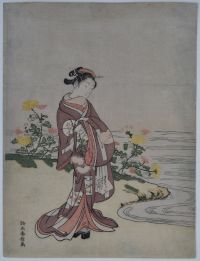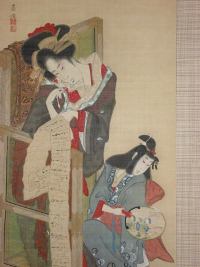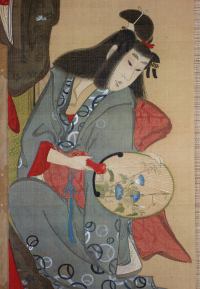1764-65 – a pivotal year for Ukiyoe-e
The years 1764/5 are now recognised as the most pivotal in the development of Ukiyo-e. Prior to this year fully polychrome prints were rarely produced. The ability to ‘key’ more than one block been known had for some time using the simple expedient of kento marks cut in relief – a right-angle in the corner, and a horizontal line down the side. However, around 1764/5, a number of favourable circumstances – namely a period of permissiveness in the arts and the proliferation of literary and poetry clubs – gave rise to the e-goyomi print (calendar-print), probably instigated by Jinshiro Tadanobu (Kikurensha Kyosen), founder of the Kikuren Club.
Calendar-prints were a government-controlled monopoly. The none-government clubs this circumnavigated by hiding the dai-sho (long and short months) numerals in various parts of a print’s design. Also, in the development of the colour print process, a tweak was made to the kento marks by the insertion of a sliver of wood; this enabled finer adjustments to be made with the keying of the blocks to compensate for expansion or contraction of the paper (or indeed the blocks). This refinement made it possible for numerous blocks to be used. The clubs commissioned the printers to use the thicker more luxurious hosho paper and a wide range of new pigments. These luxurious prints also often used over-printing and blind-printing.
Harunobu was in the right place at the right time to fully exploit these advances and the next few years would see a huge increase in Harunobu’s output, from initially designing the private e-goyomi to having them commercially sold and going on to produce a large corpus via commercial publishers. Harunobu died in 1770 but the decade saw some of the most exquisite compositions by him that were seldom surpassed in the refinement of the compositions, the palette and the printing.
Richard Kruml 2025
Maki Bokusen (1736-1824)
Given names: Bokusen; Maki-Nobumitsu Bokusen; Gekkotei; Hokusen; Hokutei; Hyakusai; Maki Shin’ei; Suke-emon; Tokoro; Utamasa.
Bokusen was a Nagoya samurai of the local Owari Fief and ukiyo-e painter, printmaker and copperplate etcher. He was a student of Utamaro and also, as C H Mitchell states, a friend and acknowledged pupil of Hokusai although much of his work bears little resemblance to that of Hokusai.
Bokusen is known for his collaboration with Hokusai on the master’s Manga: It seems that the idea was conceived when Hokusai, at Bokusen’s invitation, went to Nagoya for an extended visit in 1811/12. Hokusai stayed for six months with Bokusen and during this time developed a circle of students and successfully cultivated his popularity in Nagoya. Hanshu Sanjin in his 1812 preface to Volume One of Hokusai’s Manga writes that over 300 spontaneous drawings were made during this visit. And this is what possibly inspired Bokusen to approach the legendary Nagoya publisher Eirakuya Toshiro, who had previously published illustrated book(s) by him, to turn Hokusai’s sketches into a book. Bokusen and another of Hokusai’s students, Tonansai Hokuun, are credited as copying Hokusai’s drawings in preparation for the woodblock cutter as the term “ko” or “revisers” is used in the colophon, suggesting that it was the two pupils who arranged the varied sketches.
Bokusen’s own published works include:
c1809 Kyogaen shohen. (Mad Sketches)
1809 Bokusen gafu (Album of Sketches by Bokusen)
1810 Hitoyo banashi (One Evening’s Talk)
1813 Shiki sanbaso (The Sanbaso in Four Seasons)
1814 Mushi no koe (Songs of insects). Bokusen and other artists
1815 Bokusen soga shashin gakuhitsu (Various Dreamings by Bokusen: A Study in Truthful Painting)
1816 Santei gafu. Bokusen and Hokusai publish a Manual for Illustration in Three Styles. The illustrations in this publication apply shin, gyo, and so styles to depict a range of subjects
1822 Kusa no na shu (Aki) (Collection of Autumn Grasses). Various artists including Bokusen
1823 Ippitsu gafu (A Book of Drawings Made by One Stroke of the Brush) Hokusai assisted by Bokusen
1827 Kusa no na shu (Haru fuyu) (Collection of Spring and Winter Grasses). Various artists including Bokusen
Bokusen’s work in copperplate etching is not well known to collectors of ukiyo-e, certainly not compared with his better recognised contemporaries Kokan (1747-1818) and Denzen (1748-1822) who used the technology for familiar subjects such as famous views of Edo to create a new type of image that integrated pictorial traditions of the West. Bokusen’s work with copperplate etchings was concerned with a scientific accuracy and faithfulness to the original illustration. For the Japanese translation Surgical Medicine, he produced copper-etching prints based on the illustrations in Lorenz Heister’s Heelkundige Onderwyzingen.
Bokusen’s books, paintings and prints are held in international museum collections.
Please follow this link to see an image of his painting Courtesan and Teenage Appentice in the Museum of Fine Art Boston.
To accompany this blog I am offering for sale an original Bokusen painting, full colour on silk.



